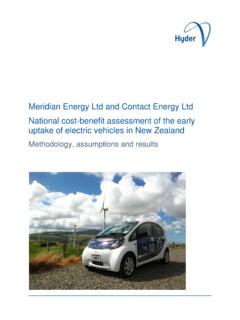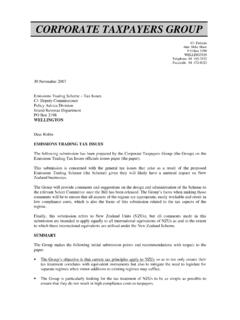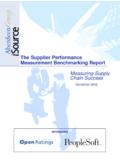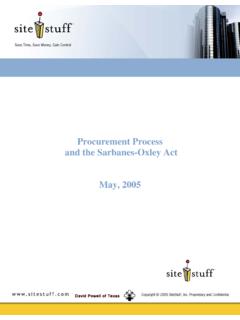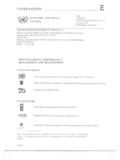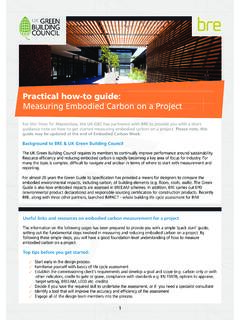Transcription of Key Performance Indicators (KPIs) - Home - SBC
1 August 2011 1 Key Performance Indicators ( kpis ) Sustainable Business Forum, Performance Benchmarking Project Introduction Key Performance Indicators Scope (SME or large) Unit Definition Guidance on measuring methods and/or documentation sources Absolute Normalised PEOPLE Absenteeism All Expressed as the rate of absence per annum Short term absence due to employee s own illness, occupational injuries or unmotivated absences. Calculated by dividing the number of absences per total number of work days scheduled for the year.
2 Maternity and long term or special leave are not considered absenteeism and should not be counted under the scheduled work days either. Employee turnover All Expressed as percentage of total number of employees The number of full time and part time employees who left the company in a given year. Information about employee turnover is routinely tracked and available from HR departments or those with accounting responsibilities in the business as part of good HR Lost Time Injury Frequency Rate (LTIFR) All Expressed as the rate of frequency per million hours worked Calculated based on the number of injuries reported for all employees per one million working hours.
3 Only injuries resulting in at least one day of lost work should be considered. For SME application: generally SMEs simply record the total number of injuries that occurred in one year. To compare Performance , SMEs will need to scale up their injury records to one million working hours. For example, for an SME with 30 employees which recorded 1 lost time injury for the year, the LTIFR is = (1 injury X 1000000) (30 employees X1920 worked hours). Skills enhancement All $ total $ total / FTE The amount of money spent on activities such as training, workshops and courses aimed at improving staff competencies and skills.
4 Information about the resources put into skills development programmes is generally available from the HR or financial departments. Other departments, administrative and otherwise, may also hold information. In case of SMEs, this information may be available with the business owners, team leaders or as part of good HR practices of accounting records. August 2011 2 Key Performance Indicators Scope (SME or large) Unit Definition Guidance on measuring methods and/or documentation sources Absolute Normalised Workplace Safety Management Practices All Primary, secondary or tertiary level The level of Performance achieved by companies participating in the ACC programme.
5 The ACC s Workplace Safety Management Practices (WSMP) programme is designed to recognise those employers who have established an acceptable benchmark for health and safety and injury prevention in the workplace. It has three levels of Performance , with tertiary affiliation being the highest level and is rewarded with a 20% reduction in ACC levy. It can be used by small and medium sized businesses, although it is considered best suited for medium sized and large businesses. The government has also introduced in April 2011 a mandatory Experience Rating Programme that will lead to a Performance ( claims history) based adjustment of the current portion of employer s levy.
6 This new programme complements the WSMP and it applied to all sized businesses. The information regarding the level of affiliation can be found with the H&S department or responsible persons in the company. ACC Experience Rating All Expressed as percentage of the loading/discount rate of the company s standard industry levy The health and safety Performance achieved by companies based on history of claims made. The Experience Rating Programme was introduced in 2011 and it is a mandatory scheme for all ACC levy contributors.
7 Companies employers, who have lower than average injury rates, with better than average rehabilitation or return to work rates, may receive a discount on their ACC work levy. Those with worse than average claims experience may receive a loading on their levy. The maximum variation for those with levies under $10,000 is +/ 10% and over $10,000 is +/ 50%. Employee engagement Large companies Expressed as proportion of engaged staff from total staff number The connection and commitment an employee has for his/her company, and motivation to contribute to company goals.
8 Generally, organisations use customised surveys of full and part time staff to determine their level of engagement. JRA Workplace Survey1 and Gallup Survey2 are known methodologies to New Zealand organisations and both determine the staff engagement ratio for three broad categories: engaged, ambivalent/neutral and disengaged. The JRA Workplace Survey, which is a combined workplace climate employee engagement survey, has been used by over 200 New Zealand organisations, including at least three SBF members. Only organisations 1 More information is available at: engagement 2 August 2011 3 Key Performance Indicators Scope (SME or large) Unit Definition Guidance on measuring methods and/or documentation sources Absolute Normalised with 20 employees or more can take the JRA survey.
9 For results to be valid, the response rate must exceed certain thresholds which depend on company size. Organisations with less than 20 employees interested to assess staff engagement can develop their own survey using online sources like survey monkey3, though anonymity considerations may prevent honest responses from staff. Other approaches and methodologies to assess engagement may be used provided they determine the proportion percentage of engaged staff and are conducted at least once per year. Gender diversity Large companies Expressed as percentage of women from total number of employees and senior management The proportion of female employees from: a.
10 Overall workforce, and b. senior management. Available with HR departments. It is envisaged that in the future other diversity dimensions will be added to the current KPI. This may include age or ethnicity. ECONOMY Direct contribution to New Zealand s economy All $ million $ million / $ million???? Total amount of payments related to three categories of expense: a. wages/salaries/benefits b. taxes, and c. NZ based supplier contracts.


